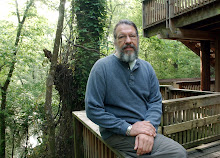(Note: for those of you arriving to this post via facebook, try using the blogspot site [type http://thenaturedude.blogspot.com/ into the top of your web browser and hit 'enter' on your keyboard] for a prettier view....)
yes, ". . . love's sweet melody . . ." remember that one, kids? ah, fats domino.......more on that, later.
it took a little over 20 years (1982-2004) for a complete tree-canopy to grow over our backyard.....the only thing we planted was a solitary baldcypress......everything else came natural......then came hurricanes lily (2004) and gustav (2008), both of which were direct eyewall hits on our place, tearing holes in our tree roof.
in the photo above, you see one of those holes, opening a view due north of our back porch....a 65' hackberry tumbled down to create it..................................................this hole perfectly frames the top of a super-emergent black willow tree, growing on the banks of a coulee about 100 yds into the surrounding woods.
relatively short-lived, and not thought of as a desirable shade tree or even wildlife tree, the black willow (Salix nigra) is nevertheless a vitally-important component in a number of louisiana habitats, including cypress-tupelo swamp, bottomland hardwood forest, hardwood riparian, freshwater marsh, etc.; and an even bigger player in human-altered wetland systems, where it functions as an early-successional or "pioneer" species.
as with all willows (worldwide, primarily in northern hemisphere temperate zones, over 500 willow species occur), black willow produces multitudes of tiny seeds, each one attached to its own silken parachute...here in louisiana, these things fill the air during late spring, landing in every conceivable locale where the wind might blow..........in a fashion akin to the wild irises and a number of other wetland-emergent plants, those seeds which happen to settle where water meets shoreline readily germinate, allowing black willow to spread itself far and wide.
amazingly (to a big dumb human, anyway), a number of bird species go after willow seed in a big way.....via the window off of our back porch, i've watched red-winged blackbirds, orchard and baltimore orioles, and indigo buntings devouring the seed of the big female willow (willows are dioecious = separate sexes on separate trees)............................they're either going after the seed, or going after insects around the seed, as i've noted these feeding episodes during the tree's seeding phase......i'm inclined to believe the latter............
willows are most famously known as producers of salicytic acid, a precurssor to aspirin. there are many references to indigenous peoples' use of willow bark to alleviate pain.....................interesting how ever since artificial anti-inflammatories have been synthesized, the corporate health care industry has poo-pooed asprin? only recently -- and only grudgingly -- have they come out and said, "yeah, a little asprin might help in preventing heart attacks".... meanwhile, we're just now beginning to hear of horrific side effects associated with acetomenophin and other non-asprin substitutes...............
in their fabulous book, 'Trees, Shrubs, and Woody Vines of Louisiana,' father-daughter botanists charles allen and dawn allen newman (along with amateur botanist, dr. harry winters) further elucidate on the properties of black willow: "The wood is soft, light, weak and not durable but does not warp, check or splinter. It is used for artificial limbs, charcoal, toys, doors, fuel, cheap furniture, boxwood, excelsior, paper pulp, and baskets. The bark is rich in tannin and used for pain relief, expectorant, hemostatic, astringent, and tonic to break up fever.......In olden times, the inner bark was used in making a light purple dye, and as a substitute for quinine. During Revolutionary Days, charcoal from black willow was used for gunpowder. The twigs are commonly browsed by deer. The tree is valuable for pollen and considerable honey has been reported from willows."
more on their book, and other essential books for louisiana plant lovers, in a later post.
green willow wood is exceedingly flexible......as kids, we used to set "willa lines" for catfish, attaching nylon string and baited hook to willow saplings hanging over the water along the various rivers, bayous, and lakes where we camped and ran trotlines and nets..........................
through recent american history the willow has appeared in numerous songs, mostly -- as in fats domino's 'blueberry hill' -- romantically swaying in the breeze...........occasionally, though, a songwriter or two has paid homage to the (sapling) willow's legendary flexibility.....or, in the case of bob dylan, lack thereof, in 'going going gone':
"I've just reached a place
Where the willow don't bend
There's not much more to be said
It's the top of the end
I'm going
I'm going
I'm gone."
right, bob..............sometimes a person just doesn't feel romantic about a willow, y'know?
speaking of willow songs, here's some cool trivia regarding fats domino's 'blueberry hill,' where "the wind in the willow played, love's sweet melody..."
- 'blueberry hill' was written in 1940 by sicilian-born american band leader vincent rose, and the tin-pan alley lyricist team of al lewis and larry stock.
- it was immediately recorded by singer tommy ryan with the sammy kaye orchestra, then POUNCED UPON, and recorded -- all in 1940 -- by the likes of gene krupa, glenn miller, gene autry, and jimmy dorsey, among others. talk about a sensation.....
- none other than louis armstrong recorded it in 1949.
- fats domino made it a hit in 1956. i was two years old then; but that didn't stop me, and you, from hearing it constantly for the remainder of our collective lives..............uh.... dam song's got legs...
- 'blueberry hill' ranks #81 on rolling stone magazine's '500 greatest songs of all time' list.



No comments:
Post a Comment